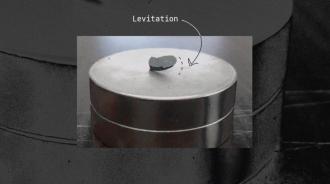Most scientific results need a little hype help. Research findings are almost always incremental advances rather than breakthroughs. However, this superconductor discovery, should it hold up to scrutiny, is everything we could hope for, no spin required. Over the past 112 years, simply laying the groundwork for a practical superconductor won three Nobel Prizes, even as the ultimate goal remained elusive. The new material, called LK-99, remains superconducting not just at room temperature but when scalding hot. It also doesn’t require enormous pressure. And, most importantly, it can be synthesized relatively simply.
Those are the claims, anyway. Many big physics discoveries — the Higgs boson at the Large Hadron Collider and gravity waves at LIGO — are esoteric and impossible outside enormous laboratories. On the flip side, LK-99 is understandable, and making and testing it is within the grasp of regular labs and little guys. It’s tangible and exciting, and efforts to replicate it have gone viral on the internet. The world now waits as scientists everywhere get to work on testing the extraordinary claim.
A brief history of superconductors
The first superconductor, reported 11 decades ago, was a similarly extraordinary claim, raising the unimagined possibility that materials could somehow flow electrical charge without resistance. (Resistance is inefficiency and results in wasted energy; it’s the reason your laptop and smartphone get hot.) In a superconductor, electrical charge circulates forever, without energy loss. It was so stunning that the physicist who discovered it — Kamerlingh Onnes — won a Nobel Prize just two years later.
Onnes’ superconductor was the element mercury cooled to 4 Kelvin (K), or -452°F, a few degrees above absolute zero, a temperature so low that it is nearly impossible to maintain outside a laboratory, rendering the scientific breakthrough an expensive novelty. The theory behind superconductivity — named BCS for John Bardeen, Leon Cooper, and John Robert Schrieffer —was developed in the 1950s, winning the three men a Nobel Prize.
Development stalled for decades as no superconductor could be found to retain its strange nature above roughly 25 K (-415°F). It was not until 75 years after Onnes’ work that physicists created a class of inorganic rare earth cuprate compounds with perfect conduction above 77 K (-321°F), freeing them to venture outside the lab with the support of liquid nitrogen. This breakthrough touched off a conference dubbed the “Woodstock of Physics,” where dozens of exultant researchers — thankfully, while remaining fully clothed — shared new superconductor discoveries with thousands of excited colleagues. The two men behind the initial work were immediately awarded the Nobel Prize.
Over the succeeding 30 years, superconductors that functioned at substantially higher temperatures — think South Pole, rather than Pluto — could not be found. Claims have appeared recently, but they were limited to minuscule samples crushed to massive pressures of thousands or millions of atmospheres in diamond presses. Other scientists then noticed discrepancies in the reports. Suspicion grew as the field came to believe that the central researcher had committed substantial plagiarism and data manipulation in multiple papers. Scandal entirely consumed the results. It seems a fair betthat these “discoveries” were baloney.
LK-99
That brings us to today. The announcement of LK-99 by a South Korean research group was a lightning bolt leaping from a blue sky. No one expected it; there was no promising lead-up. Facing an extraordinary and unanticipated claim and wary from the recent scandals, many researchers were initially skeptical.
Within days, a top American scientific laboratory ran a quick study modeling the superconductor and finding it plausible. A Chinese lab made calculations but refrained from passing judgment. One Chinese experimental team reported synthesis but no magic at room conditions, while another just released an excited and promising but sloppy report. This is only the opening salvo. An army of replicators belonging to national laboratories, research universities, and amateur garages is rushing to replicate ambient superconductivity in LK-99.
Fog of research
Right now, we are in the “fog of war” stage. Reports are all over the place: no superconductivity, some superconductivity, failed tests, promising tests, promising calculations, and strange videos of floating flakes. Experts and amateurs alike are crowding into old-fashioned internet forums to catalog and analyze them.
Reading the original LK-99 papers as a physicist, but not an expert in this particular field, a few things stand out. Onereport is riddled with imprecise language, poor images, and formatting issues. The other is better but still rough. I would attribute this to the South Korean team rushing to publish a big result, but some of the response studies, written in a matter of days, are of higher quality. It is possible that the team was not as careful as it should have been with such a momentous announcement.
However, it is still intriguing. Copper ions substituting for lead ions to shrink the lead apatite crystal volume and rearrange electron bands is plausible. The analysis is comprehensible, and the theoretical justifications are scientifically plausible. The evidence is substantial: multiple tests of superconductivity, analytical measurements, structure models, and even photographs of the material under synthesis, finished, and levitating. The work is not subtle, obscured, or debatable. Either they have it or they don’t.
Watch and wait
Over the next few weeks or perhaps months, the claim will hold up or be debunked by dozens of replication attempts. These first tests will reveal the likely answer. It will take another year or so for LK-99 to be thoroughly scientifically vetted to be sure.
One thing is for certain: The lead scientists have tremendous confidence in their work. They have submitted two papers for scientific peer review. One of them only has three authors — the greatest number that can share a Nobel Prize.
This article was reprinted with permission of Big Think, where it was originally published.






